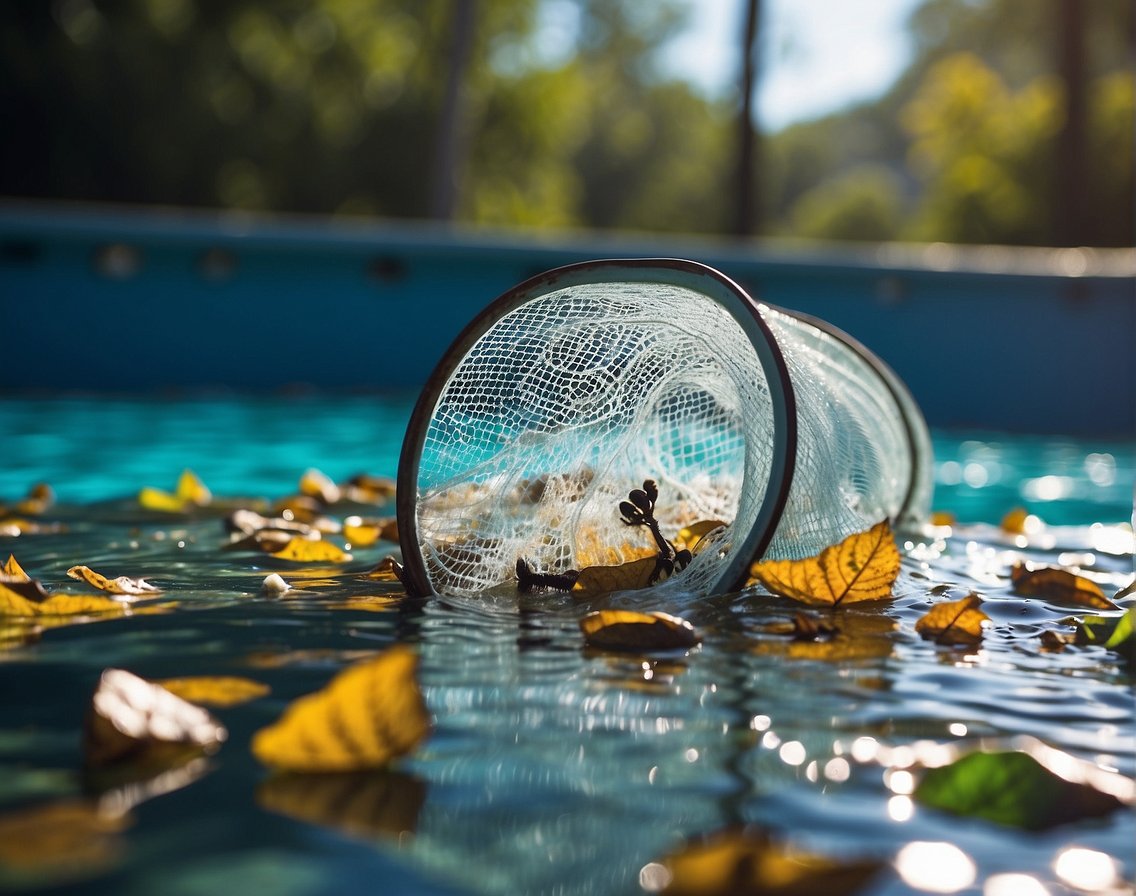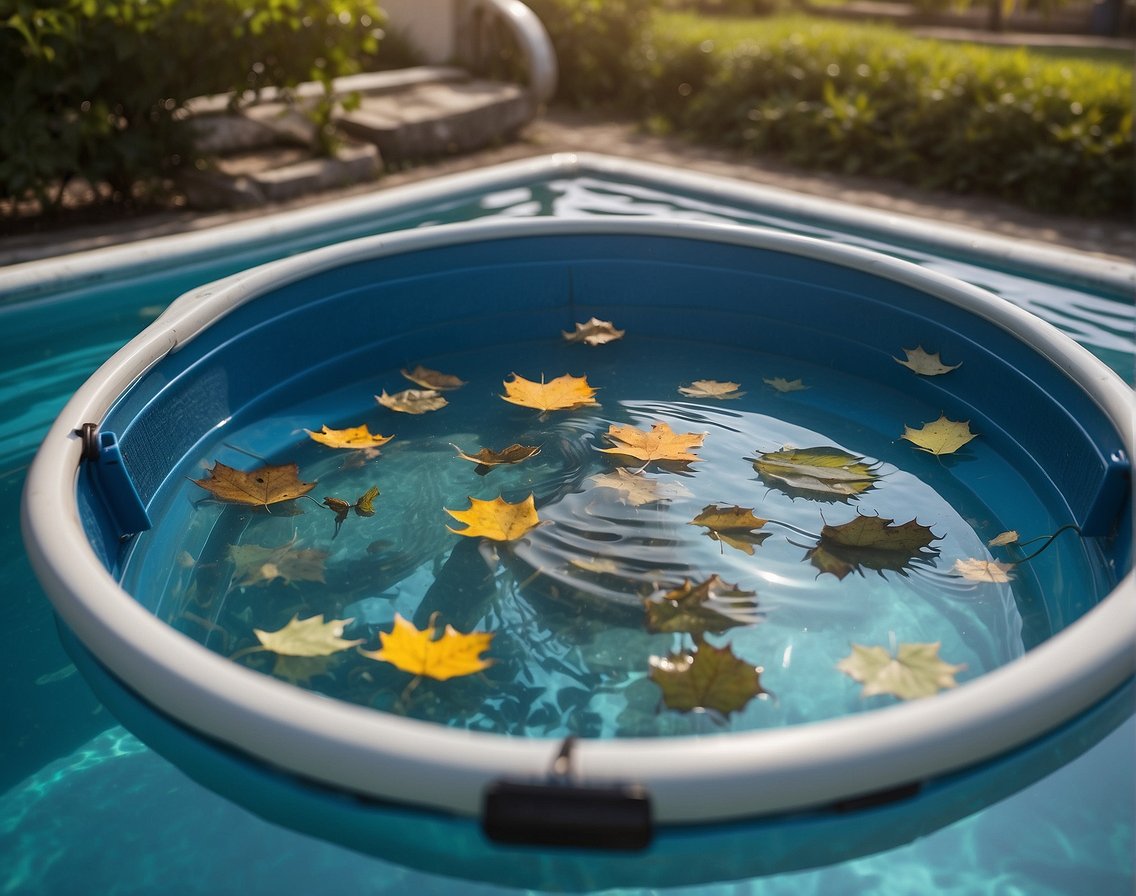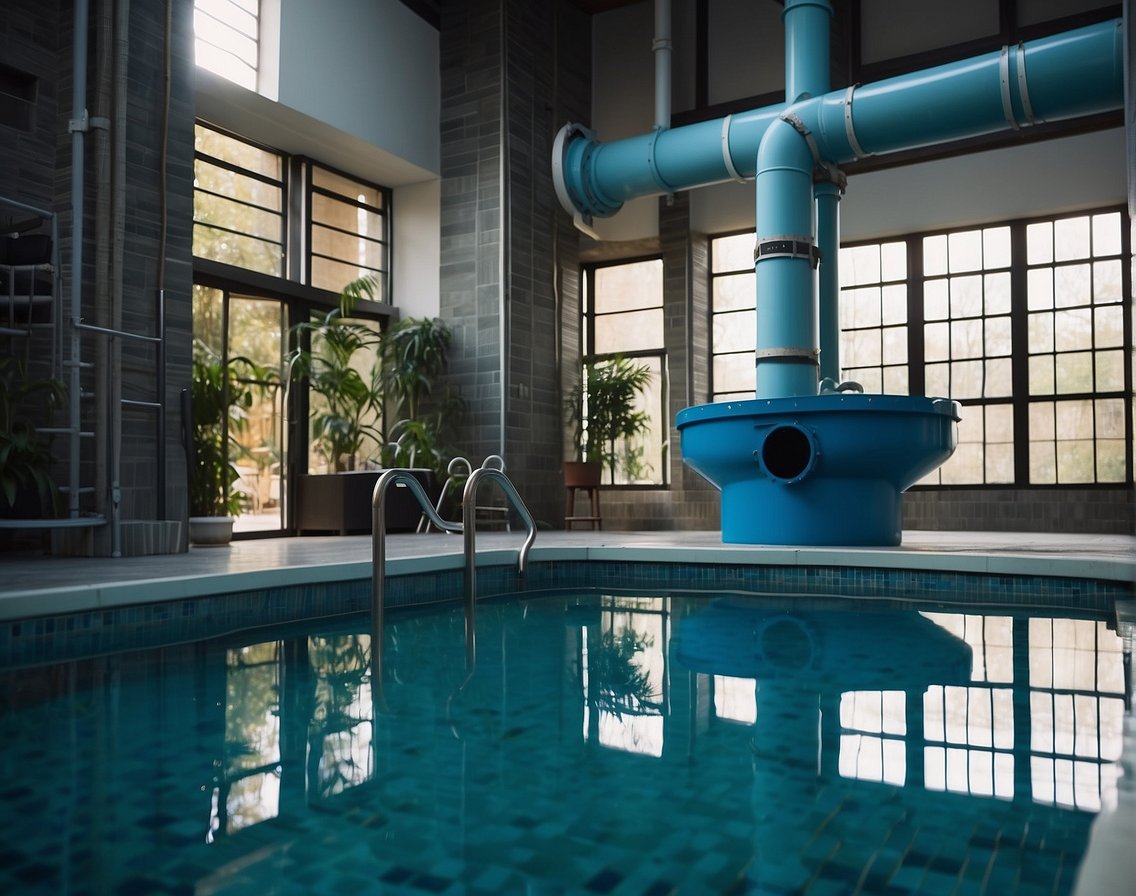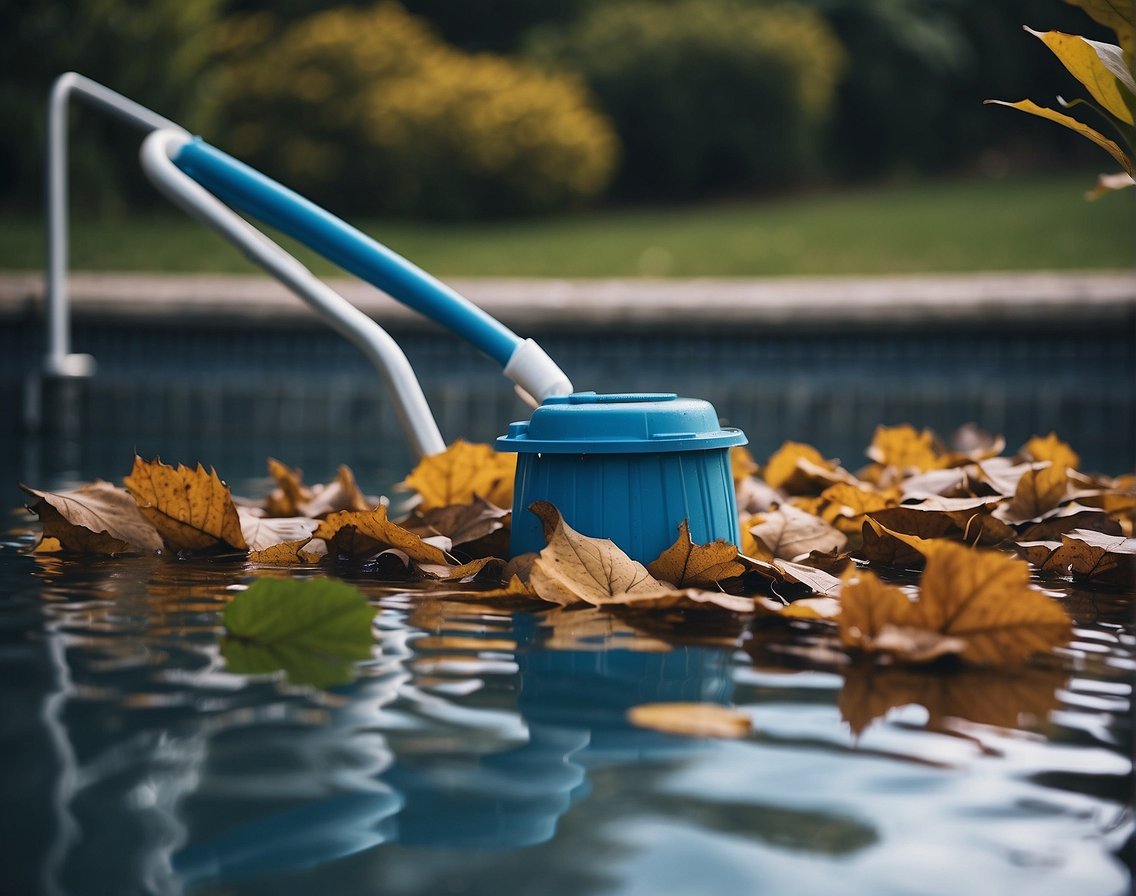Understanding Pool Skimming Essentials

In our guide to pool skimming essentials, we aim to provide clarity on the importance of skimmers in water quality maintenance, the different types of skimmers available, and the specific techniques that cater to various kinds of debris.
The Role of Skimmers in Maintaining Water Quality
Pool skimmers are crucial in preserving the health and clarity of our pool water. They function as a first defense, catching leaves and debris before they sink and decay, which can affect water quality and place additional strain on the pool’s filtration system. Regular maintenance of pool skimmers, including cleaning out the skimmer basket, ensures that they operate efficiently and reduce the workload on the filtration system, aiding in overall pool maintenance.
Types and Functions of Different Skimmers
- Manual Skimmers: Typically a net is attached to a long pole, these are simple to use and provide us with the control needed to remove debris from the water surface.
- Automatic Skimmers: These skimmers connect to the pool’s filtration system. As water is drawn into the skimmer, debris is collected in the skimmer basket. They are efficient and aid in continuous maintenance.
- Robotic Skimmers: Independently powered by electricity or solar energy, they move across the surface of the water, collecting debris into an onboard basket, and are ideal for frequent pool cleaning.
Each type of skimmer has its place in our pool maintenance routine. We balance their use according to the specific needs of our pool and the typical debris we encounter.
Skimming Techniques for Various Debris
For leaves: we use a wide-mesh net to make sure they’re caught easily without causing the skimmer to clog. We skim gently across the surface to collect the leaves effectively.
For finer debris such as small insects or pollen, a finer mesh skimmer net is best. The technique here is slower, steady passes which ensure that even the smallest particles are captured.
To maintain optimal water quality and pool health, each type of debris requires a slightly different skimming tool and approach. By using the appropriate skimming techniques and performing regular maintenance, we ensure that our pool remains a clean and enjoyable environment.
Manual Vs. Automatic Skimming Methods

When it comes to maintaining a clean pool, effective skimming is essential. We’ll look at manual and automatic methods, evaluate their efficacy, and consider their maintenance needs.
Manual Pool Skimmers and Techniques
With manual skimming, we primarily use a skimmer net attached to a telescopic pole. This allows us to reach debris across the pool’s surface. Certainly, manual skimming offers us direct control over the cleaning process and is especially useful for removing large debris like leaves. Here’s our technique:
- Survey the Pool: We first assess the types and amounts of debris present.
- Large Debris Removal: Using a flat skimmer net, we scoop out leaves and bugs.
- Small Particle Skimming: A deeper net or a skimmer with a fine mesh helps us capture smaller particles.
- Skimmer Weir Utilization: If our pool has a built-in skimmer weir, we ensure it’s clear of obstructions to maximize water flow and debris capture.
It’s worth noting that manual skimmers require no energy consumption, but the effectiveness hinges on our consistency and effort.
Automatic Pool Skimmers for Efficient Cleaning
Automatic pool skimmers, including automatic pool cleaners and robotic skimmers, streamline pool maintenance. Here’s how these systems benefit us:
- Robotic Skimmers: They work independently of the pool’s filtration system, skimming the surface to collect debris. Some models intelligently adapt to the pool’s shape and size.
- Automatic Pool Cleaner Attachments: These devices attach to our existing pool filtration system, moving around to skim and vacuum the pool.
Both options significantly reduce our manual labor but involve higher upfront costs and potential maintenance expenses.
Comparing Skimming Efficacy and Maintenance Needs
We must consider both efficacy and upkeep when choosing between manual and automatic skimming methods.
| Feature | Manual Skimming | Automatic Skimming |
|---|---|---|
| Initial Cost | Low | High |
| Energy Consumption | None | Varies |
| Maintenance Costs | Low | Higher |
| Upkeep Involved | High Effort | Low Effort |
| Efficacy for Large Debris | High | Medium to High |
| Efficacy for Small Debris | Medium | High |
Overall, manual skimmers have low initial and maintenance costs but require significant physical effort and regular attention. Automatic skimmers offer ease of use and can handle a range of debris types effectively, but they come with higher initial investment and maintenance costs. We must weigh these factors based on our specific pool requirements, budget, and personal preference for hands-on maintenance versus automated convenience.
Advanced Skimming Technologies and Equipment

In the realm of pool maintenance, advanced skimming technologies have revolutionized how we keep our water clean. From energy-efficient devices to more effective debris collection methods, these tools are essential for any pool owner looking to maintain a pristine swimming environment.
Robotic Skimmers and Solar-Powered Innovations
Robotic Pool Skimmer
- Design: Streamlined and efficient, capable of navigating the pool’s surface autonomously.
- Operation: Utilizes onboard sensors to detect and collect debris.
- Energy: Most models are battery-operated, with some integrating solar-powered solutions to extend operational time.
Solar-Powered Skimmers
- Energy Efficiency: Harness solar energy, reducing the need for electrical power.
- Build: Durable and often come with UV-resistant materials.
- Suitability: Work well in both in-ground pools and above-ground pools.
Floating Skimmers and Their Unique Advantages
Floating pool skimmers present a simple yet innovative approach to pool cleaning. Unlike the fixed inground pool skimmer or mounted skimmer, these devices move freely on the water surface.
Advantages
- Agility: Easily adapt to changing water levels and pool shapes.
- Installation: No need for hoses or complex setups; they’re ready to use right out of the box.
- Compatibility: Ideal for use in various pool types, including above-ground and in-ground configurations.
Key Features and Enhancements in Skimming Devices
We value features that maximize efficiency and convenience. Let’s look at some key enhancements:
- Connectivity: Some skimmers can connect to smart home systems for remote monitoring and control.
- Durability: Look for robust builds that offer longevity and resistance to pool chemicals.
- Vacuum Power: The strength of the vacuum affects how well the device picks up debris. Enhanced vacuum capabilities mean cleaner pools.
Notable Features to Consider:
- Debris Collection: High-capacity baskets or containers for less frequent emptying.
- Automation: Programmable cycles and self-adjusting capabilities for various pool conditions.
- Energy: Solar enhancements and efficient motors save energy without sacrificing performance.
Optimizing Your Pool’s Filtration System

Properly optimizing our pool’s filtration system ensures efficient removal of debris and maintains water clarity. It’s essential that we pay close attention to how our skimmers work with our pool pump and filter, maintain optimal water circulation, and keep our skimmer baskets in top condition.
Strategic Use of Skimmers with the Pool Pump and Filter
Skimmers are our first line of defense in keeping the pool clean. We should ensure the skimmers are not obstructed and the water level is adequate to facilitate smooth skimming action. By running our pool pump during peak debris times, such as after a storm, we enhance the skimmer’s effectiveness. Additionally, routinely checking and cleaning the basket within the skimmer can prevent clogs that impair suction and filtration.
- Check: Daily inspection of skimmer baskets for debris.
- Clean: Regularly, to maintain optimal flow and prevent damage to the pump and filter.
Ensuring Proper Water Circulation and Filtration
The goal is to achieve even water circulation which prevents debris from settling and makes sure pool chemicals are evenly distributed. This involves verifying that our pool filter is functioning correctly and not obstructed. We might also consider the position of our return jets; angling them can enhance circulation and filtration efficiency. It’s important to continuously monitor the system’s pressure gauge and perform backwashing when necessary.
- Monitor: Pressure levels and perform backwashing as required.
- Adjust: Return jets to promote better water flow and distribution.
Maintenance Tips for Skimmer Baskets and Accessories
Regular maintenance extends the life of our pool accessories and keeps the filtration system running smoothly. We should replace skimmer baskets if they are cracked or damaged to ensure that the suction is not impeded. Skimmer weirs must also be in good working order to maximize suction efficiency. When we clean the pool, attention should be paid to both the physical removal of large debris and the checking of pH levels to keep the water balanced.
- Replace: Damaged skimmer baskets and weirs to prevent loss of suction.
- Balance: Water chemistry, including pH levels, to aid in the effective use of pool chemicals.
Properly maintaining and optimizing our pool’s filtration system is an ongoing effort. By giving attention to these aspects, we ensure a clean and inviting pool environment.
Troubleshooting Common Pool Skimmer Issues

In our experience, addressing skimmer issues promptly ensures a clean and functional swimming environment throughout the pool season. We’ll discuss direct solutions to enhance skimmer performance and longevity.
Addressing Skimmer Blockages and Suction Problems
- Inspect the Weir: Regularly check the skimmer weir; it must move freely to regulate debris inflow and maintain proper suction. If it’s stuck, remove and clean it to avoid restricting water flow.
- Verify Suction Line: Ensure the suction line is clear. A blockage can severely reduce skimmer efficiency. If needed, use a plumbing snake to dislodge debris from the line.
- Check the Lid Seal: A loose lid can introduce air into the system and reduce suction. Examine the lid for cracks and ensure it’s sealed tightly.
- Main Drain Balance: Adjust the valves to balance the flow between the main drain and the skimmer, optimizing debris removal.
Replacing Skimmer Parts and Preventing Wear
- Gaskets and Seals: Periodically replace skimmer gaskets and seals to prevent air leaks. Keeping components snug ensures optimal suction and skimmer performance.
- Basket Durability: Inspect the skimmer basket for damage. Replace it if it shows signs of wear, as it is essential for trapping larger debris without impeding water flow.
Maintaining Skimmer Efficiency Throughout the Pool Season
- Regular Clean Outs: Empty the skimmer basket weekly or more often if necessary to prevent overflow and maintain efficiency.
- Ideal Chlorine Levels: Too many chlorine tablets can cause corrosion and damage to skimmer parts. Monitor and maintain appropriate chemical levels to prevent unnecessary wear.
- Algae and Mold Prevention: A clean skimmer is less likely to harbor mold and algae. Routinely scrub the basket and the interior of the skimmer to maintain its condition.
- Vacuum Hose Maintenance: Check the vacuum hose for leaks, which can reduce the suction power of the skimmer, and patch or replace as needed to ensure it functions properly.
By incorporating these subsections into our pool maintenance routine, we ensure the skimmer operates effectively throughout its lifespan.
Frequently Asked Questions
In this section, we address common queries regarding pool skimming techniques for various types of debris, ensuring your pool remains pristine and inviting.
What is the most efficient way to skim a pool?
We find that using a wide, flat net attached to a telescoping pole allows us to cover more surface area and collect debris quickly, making it a very efficient method for skimming pools.
How do I get rid of heavy debris in my pool?
For heavy debris like leaves, twigs, and insects, we recommend employing a heavy-duty leaf rake with a deep bag. This allows us to scoop up a large amount of debris all at once, reducing the strain on the pool’s filtration system.
How do I get rid of microscopic debris in my pool?
Removing microscopic debris requires a pool skimmer with a fine mesh net or a pool vacuum system with a fine filter to capture small particles. Utilizing flocculent to clump the debris together before vacuuming can also be an effective strategy.
How do you skim small debris from a pool?
We target small debris, such as sand or silt, by employing a fine mesh skimmer or by using a pool vacuum cleaner with proper filtration. Regular use of these tools is key to maintaining water clarity.
What is the difference between manual and automatic pool skimmers?
The main difference lies in the user involvement and power source. Manual skimmers require us to physically remove debris using a hand-held net, while automatic skimmers work independently, using the pool’s circulation system or separate power to trap debris.
What are the benefits of using a robotic pool skimmer?
Robotic pool skimmers offer us the advantage of being hands-free, energy-efficient, and highly effective at keeping the pool clean. They operate independently of the pool’s filtration system and can reach debris across the entire pool surface.
